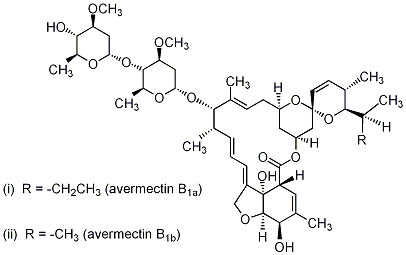Welcome to Union-agrochemCrop Protection Technology (Shanghai) Co.,ltd
Toggle Navigation

NOMENCLATURE
Common name abamectin (BSI, E-ISO, ANSI); abamectine ((f) F-ISO)
IUPAC name (10E,14E,16E)-(1R,4S,5′S,6S,6′R,8R,12S,13S,20R,21R,24S)-6′-[(S)-sec-butyl]-21,24-dihydroxy-5′,11,13,22-tetramethyl-2-oxo-3,7,19-trioxatetracyclo[15.6.1.14,8.020,24]pentacosa-10,14,16,22-tetraene-6-spiro-2′-(5′,6′-dihydro-2′H-pyran)-12-yl 2,6-dideoxy-4-O-(2,6-dideoxy-3-O-methyl-α-L-arabino-hexopyranosyl)-3-O-methyl-α-L-arabino-hexopyranoside (i) mixture with (10E,14E,16E)-(1R,4S,5′S,6S,6′R,8R,12S,13S,20R,21R,24S)-21,24-dihydroxy-6′-isopropyl-5′,11,13,22-tetramethyl-2-oxo-3,7,19-trioxatetracyclo[15.6.1.14,8.020,24]pentacosa-10,14,16,22-tetraene-6-spiro-2′-(5′,6′-dihydro-2′H-pyran)-12-yl 2,6-dideoxy-4-O-(2,6-dideoxy-3-O-methyl-α-L-arabino-hexopyranosyl)-3-O-methyl-α-L-arabino-hexopyranoside (ii) (4:1)
Chemical Abstracts name 5-O-demethylavermectin A1a (i) mixture with 5-O-demethyl-25-de(1-methylpropyl)-25-(1-methylethyl)avermectin A1a (ii)
Other names avermectin B1
CAS RN [71751–41–2] abamectin; [65195–55–3] (i); [65195–56–4] (ii)
EC no. 265–610–3 avermectin B1a; 265–611–9 avermectin B1b
PHYSICAL CHEMISTRY
Composition A mixture containing ≥80% avermectin B1a (i) and ≤20% avermectin B1b (ii). Mol. wt. 873.1 (avermectin B1a); 859.1 (avermectin B1b) M.f. C48H72O14 (avermectin B1a); C47H70O14 (avermectin B1b) Form Colourless to pale yellow crystals. M.p. 161.8-169.4 °C (decomp.) V.p. <3.7 × 10-3 mPa (25 °C) Kow logP = 4.4±0.3 (pH 7.2, room temperature) Henry 2.7 × 10-3 Pa m3 mol-1 (25 °C) S.g./density 1.18 (22 °C) Solubility In water 1.21 mg/l (25 °C). In toluene 23, acetone 72, methanol 13, octanol 83, ethyl acetate 160, dichloromethane 470, hexane 0.11 (all in g/l, 25 °C). Stability Stable to hydrolysis in aqueous solutions at pH 5, 7, and 9 (25 °C). Sensitive to stronger acid and base. UV irradiation causes conversion first to the 8,9-Z- isomer, then to unidentified decomposition products. Specific rotation [α]D22 +55.7° (c = 0.87, CHCl3)
APPLICATIONS
Biochemistry Acts by stimulating the release of γ-aminobutyric acid, an inhibitory neurotransmitter, thus finally activating chloride channels. See M. J. Turner & J. M. Schaeffer in Ivermectin and Abamectin, p. 73. Mode of action Insecticide, acaricide and nematicide with contact and stomach action. Has limited plant systemic activity, but exhibits translaminar movement. Uses Control of motile stages of mites, leaf miners, suckers, Colorado beetles, etc. on ornamentals, cotton, citrus fruit, pome fruit, nut crops, vegetables, potatoes, and other crops. Application rates are 5.6 to 28 g/ha for mite control, 11 to 22 g/ha for control of leaf miners. Also used for control of nematodes by seed treatment, and of fire ants. Phytotoxicity May be phytotoxic to pome fruit when mixed with captan. Formulation types EC. Compatibility Not compatible with captan.
ENVIRONMENTAL FATE
Animals Rapidly eliminated (80–100% in 96 h), mainly via faeces; urinary excretion was 0.5–1.4%. Plants Degradation/metabolism in each of three different plants is similar and occurs predominantly by photolysis on the plant surfaces. The definition of the residues is thus expressed as the combined residues of avermectin B1 and its 8,9-Z-avermectin B1 photoisomer. Soil/Environment Binds tightly to soil, with rapid degradation by soil micro-organisms. No bioaccumulation.
MAMMALIAN TOXICOLOGY
Oral Acute oral LD50 (in sesame oil) for rats 10, mice 13.6 mg/kg; (in water) for rats 221 mg/kg. Skin and eye Acute percutaneous LD50 for rabbits >2000 mg/kg. Mild eye irritant; non-irritating to skin (rabbits). NOEL for rats (2 generation reproduction study) 0.12 mg/kg b.w. daily. ADI (JMPR) 0.002 mg/kg b.w. [1997] (for sum of abamectin and 8,9-Z- isomer); 0.001 mg/kg b.w. [1995] (for residues not containing Δ-8,9- isomer); (EC) 0.003 mg/kg b.w. [2008]; (EPA) aRfD 0.00025 mg/kg b.w., cRfD 0.00012 mg/kg b.w. [2005]. Other Non-mutagenic in the Ames test. EPA (formulation) IV
ECOTOXICOLOGY
Birds Acute oral LD50 for mallard ducks 84.6, bobwhite quail >2000 mg/kg. Fish LC50 (96 h) for rainbow trout 3.2, bluegill sunfish 9.6 μg/l. Daphnia EC50 (48 h) 0.34 ppb. Algae EC50 (72 h) for Pseudokirchneriella subcapitata >100 mg/l. Other aquatic spp. LC50 (96 h) for pink shrimps (Panaeus duorarum) 1.6, blue crabs (Callinectes sapidus) 153 ppb. Bees Toxic to bees. Worms LC50 (28 d) for earthworms 28 mg/kg soil.